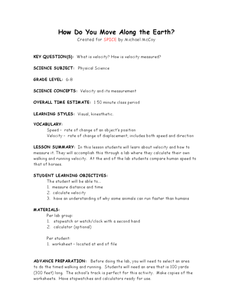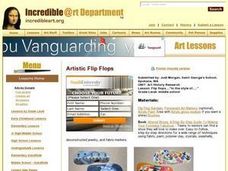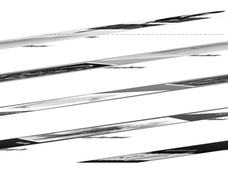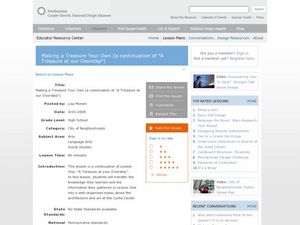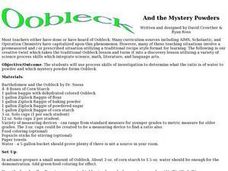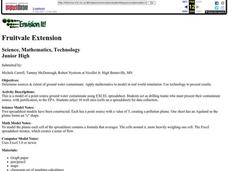Curated OER
Listening and Speaking Skills, Strategies, and Applications
Twelfth graders summarize a speaker's purpose and point of view. In this speaker's purpose lesson, 12th graders watch a video clip from one of the major morning news programs to observe the speaker's point of views. Students determine...
Curated OER
Civil War
Students explore the Civil War. In this U.S. Civil War U.S. history lesson, students participate in a cubing activity in which a variety of Civil War projects are described on a paper cube. Students roll the cube to determine which...
Curated OER
The Mier Expedition
Seventh graders explore the significance of the Mier Expedition to the Republic of Texas. They discuss the suffering Texans endured during their escape attempt and incarceration. Using first hand interviews and recollections, 7th graders...
Curated OER
Reading Word Recognition, Fluency, and Vocabulary
Eleventh graders analyze words that derive meaning from Greek, Roman, and Norse myths. In this myth vocabulary lesson, 11th graders work in learning groups as visual learners, kinesthetic learners, and artistic learners to identify the...
Curated OER
How Do You Move Along the Earth?
Students determine their own walking and running velocity. In this physics instructional activity, students calculate velocity using distance and time information. They compare human and animal speeds.
Curated OER
Marble Madness
Middle schoolers determine the velocity of a marble rolling down the incline. In this physics lesson plan, students identify the independent and dependent variables in the experiment. They construct and analyze a graph.
Curated OER
Lorenzo de Zavala Online: Empresario, Statesman and Texas Revolutionary
Seventh graders study Lorenzo de Zavala's role in the Texas Revolution as politician and statesman. They determine his contributions to the establishment of a government as Texas fought for its independence. While completing research,...
Curated OER
Flip flops....In the style of.....
Learners create a pair of flip flops. Using the internet, they become familiar with the work of a specific artist and make their flip flops in the same design. They write a report on the information they gather about the artist and...
Curated OER
Time, Talent, Treasure and Economics
Students work cooperatively to create a quilt. They choose a pattern and determine the specific skills and steps needed to produce that quilt. Labor is divided equally between group members and a quilt is created assembly line style....
Curated OER
Oh Picasso!
Learners identify the painter Picasso as a famous Spanish cultural figure, name at least one of Picasso's painting styles and describe aspects of Picasso's Blue Period. They create their own Blue Period inspired work of art.
Curated OER
FAMOUS PAINTING
Students provide a brief history of Van Gogh and of the artists working at the same time. They use images of the furniture copied from the painting to review vocabulary items, color, size, etc. They draw and color a rendition of their...
Curated OER
Horsepower: Harnessed for War
Students explore the technology of war. In this war technology lesson, students research the fighting styles of the Vikings, the Normans, and Medieval Knights.
Curated OER
Reef Fish Real Estate in the South Atlantic Bight
Learners research a species of reef fish to determine its habitat requirements as both a juvenile and an adult. They use this information to create a pamphlet in the style of a real estate brochure that describe the habitat and food...
Curated OER
Where the Red Fern Grows: A 4th Grade Literary Focus Unit
Fourth graders explore the human and animal connection along with the idea that death is a part of the life cycle. They read "Where the Red Fern Grows." Students examine the feelings and emotions surrounding death and they discover the...
Curated OER
To See or Not to See
Students identify and discuss key factors that determine how effective color camouflage is in certain habitats. In this investigative lesson students divide into groups and study light.
Curated OER
Making a Treasure Your Own: Lesson Two
High schoolers write an essay describing the Curtis Center and what they learned there. In this descriptive writing essay, students discuss the five paragraph essay and review sensory discoveries from their trip. High schoolers draft an...
Curated OER
Hemispheres & Continents
Students learn in cooperative learning groups to determine how the equator and the Prime Meridian divide the earth into hemispheres and use Venn diagrams. Students will locate and label the hemispheres, continents, and oceans.
Curated OER
Centennial: Home Sweet Home
Students research the history of a home, including ownership titles, land grants, etc, in order to determine how homes can serve as a vehicle for the study of history. They Create a display of the styles and changes that the house has...
Curated OER
All That is Irish and More - Activity 1
Students listen to examples of fiddle music and violin music to determine the similarities and differences between the two musical forms. A video link is included in this introductory lesson to fiddle music (Part One of Two).
Curated OER
Oobleck and the Mystery Powders
Students listen to the book, "Oobleck," by Dr. Suess before experimenting with mystery powders. They determine the proper ratio of powder to liquid to make the Oobleck.
Curated OER
Fruitvale Extension
Students determine sources and extent of ground water contaminate, apply mathematics to model in real world simulation, and use technology to present results.
Education World
Mystery State #29
In this United States mystery worksheet, young scholars determine which state is described by the 5 clues listed on the sheet and then mark it on the outline map of the United States.
Curated OER
Cultural Collision
Students examine the culture of the Native Americans. As a class, they discuss the negative impact of the melting pot theory and how different cultures can be preserved today. In pairs, they practice saying Native American words and...
Curated OER
Do We Have to Do This?
Learners conduct Internet research, and read articles about education to determine why particular educational practices are used, and why they are important in terms of No Child Left Behind. Students create PowerPoint presentations...






